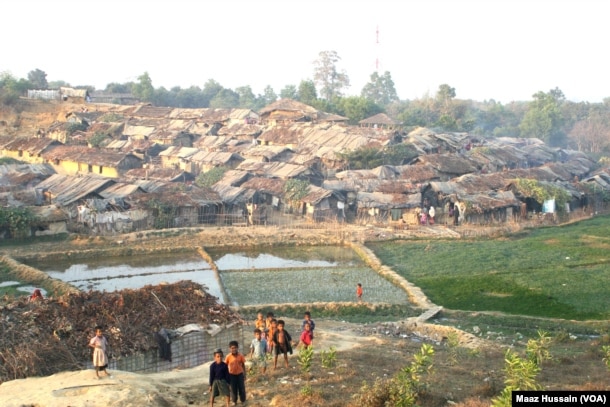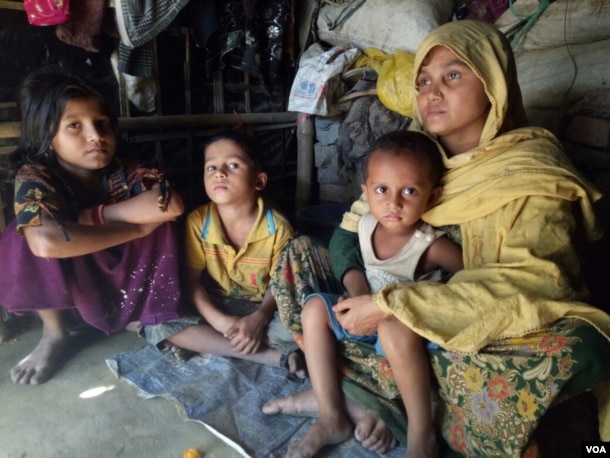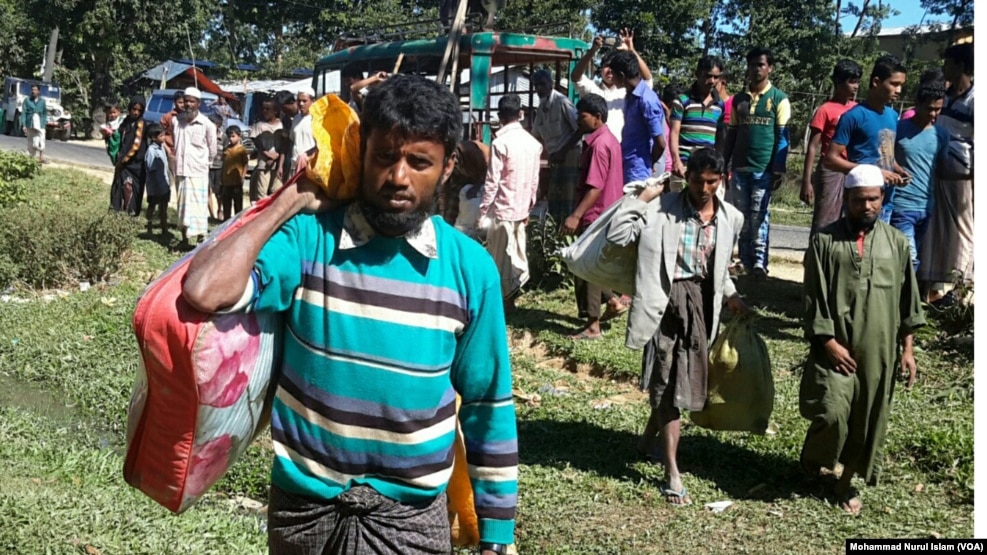Authorities in Dhaka have demanded that Myanmar repatriate tens of thousands of Rohingya Muslims who crossed the border to escape what they say is persecution, and are now living illegally in Bangladesh.
Myanmar says it will accept a small fraction of the refugee population now in Bangladesh, but the Rohingya themselves say they are unwilling to go back to Myanmar’s Rakhine state. Refugee community leaders are appealing to “Rohingya-friendly” countries to take them in.
Ko Ko Linn, a Rohingya community leader in Bangladesh, told VOA that conditions in Myanmar had become unlivable, particularly in recent weeks, and “they do not want to return to this anti-Rohingya Myanmar.”

Rohingyas who fled Myanmar over the past decades live in this decrepit Kutupalong illegal Rohingya refugee colony in Cox’s Bazar district, Bangladesh.
‘Unlivable’ situation
Linn, an executive member of the Arakan Rohingya National Organization, said, “The Myanmar government and the country’s Buddhist-majority society have turned extremely hostile against the Rohingya Muslims, turning the country into a hell for them.”
An Amnesty International report last month accused Myanmar security forces of being responsible for unlawful killings, multiple rapes and the burning down of houses and entire villages in a “campaign of violence against Rohingya people that may amount to crimes against humanity.”
The Foreign Ministry of Bangladesh called in Myanmar’s ambassador Thursday to complain about the refugees and to demand an early return of all Rohingya migrants to Myanmar.
Kamrul Ahsan, Bangladesh’s Bilateral and Consular Secretary, told Ambassador Myo Myint Than there is “deep concern at the continued influx of Muslims” from Myanmar.
A Foreign Ministry statement in Dhaka said Ahsan asked “the Myanmar government to urgently address the root cause of the problem,” so that the Rakhine Muslims are not forced to flee Myanmar and seek shelter in Bangladesh.
Less than 1 percent can return
One day after that tense meeting in Dhaka, Myanmar said it would agree to accept the return of fewer than 2,500 Rohingya from Bangladesh — less than 1 percent of the total refugee population, which is estimated to be at least 350,000 people.
Authorities in Yangon contend most of the impoverished Rohingya now seeking shelter in Bangladesh are not citizens of Myanmar, because they are descended from illegal immigrants who arrived years ago. The Rohingya, however, claim their community has lived where Myanmar is located for several centuries.
Separately, Bangladesh’s foreign secretary, Shahidul Haque, said Myanmar’s Aung San Suu Kyi is expected to send a special envoy to Bangladesh soon, to take stock of the Rohingya refugee situation.
Violence directed at Rohingya Muslims has broken out in Myanmar sporadically in recent years, and members of the Muslim minority fleeing persecution kept crossing over to southeastern Bangladesh, which lies adjacent to their home villages in Rakhine state. The situation worsened considerably 11 weeks ago, however, after nine Myanmar border guards were killed in an armed attack blamed on Rohingya militants.
Refugee tide swelled recently
A military crackdown in Myanmar that followed the border attack has been blamed for human rights abuses including extrajudicial killings, rapes and arson in Rohingya villages. In those recent weeks up to 50,000 Rohingya men, women and children have crossed into Bangladesh seeking safety.
Bangladeshi officials’ estimates of the Rohingya population vary, but most contend there are 350,000 to 500,000 Rohingyas living in Bangladesh, over 90 percent of whom are illegal refugees.
Bangladesh, one of the world’s most densely populated countries, has long complained that its congested urban areas and villages cannot cope with the burden of Rohingya refugees pouring into the country. About 10 years ago, Bangladesh quietly adopted a policy to push the refugees back to Myanmar, yet the Rohingyas have consistently managed to return, slipping through the porous border, usually by river crossings.
Authorities in Myanmar, formerly known as Burma, claim that all the allegations of abuse, killings and rapes by soldiers are fictitious, but such complaints by newly arrived refugees have increased dramatically since October. The Rohingya say they have been the victims of violence by Buddhists in Rakhine, also known as Moghs, as well as government soldiers.

Habiba, 32, and her three children at a Rohingya village in Bangladesh. According to the Rohingya woman, she was raped by a Burmese soldiers and a Mogh, after her husband was beaten up and taken away from her village in Rakhine in December.
Hasina Begum, who has been staying in the illegal Rohingya settlement of Kutupalong in Bangladesh since November, said that under no circumstances would she agree to return to Myanmar.
“Soldiers and Moghs were raping and torturing the people around us. My children were murdered. I was beaten and they broke my waist. My husband was taken away by the soldiers and he has disappeared since then,” Begum told VOA.
“Moghs looted my house before burning it. … Unable to bear this torture I have fled to Bangladesh,” she continued.
“If Bangladesh says we must go back, we shall kill ourselves. But we will not return to Myanmar,” the Rohingya woman added.
Nuruzzaman, a 55-year-old Rohingya man, told VOA, “I had eight members in my family. I lost three of them, including my young daughter, to the violence there. To save our lives five of us have fled to Bangladesh. … In Burma they say, ‘You belong to Bangladesh.’ In Bangladesh they are saying, ‘you belong to Burma.’
“Where shall we go? … The world is so big. Is there not some space for the Rohingyas to live?”

Noor Ayesha, 40, and her daughter at an illegal Rohingya settlement in Bangladesh.
Hoping to refuge in Muslim-majority countries
Nuruzzaman said he hoped Muslim-majority countries like Malaysia, Indonesia, Pakistan, Saudi Arabia or Turkey, all of whom have been sympathetic to the Rohingyas’ cause, could provide refuge.
“They can perhaps arrange our transportation from Bangladesh to their countries by ship or plane,” the refugee told VOA. “That way, perhaps, the Rohingyas could be saved from dying a bad death here.”
Nurul Islam, a Britain-based Rohingya rights activist and community leader, said that there is an exodus from Rakhine state because Rohingyas there “are desperate to save their lives.”
“By just crossing a river they can reach safety, they know,” said Islam, who is president of the Arakan Rohingya National Organization, told VOA.
“If Bangladesh really does not want to host these refugees any more and some other countries are willing to help,” Islam told VOA, “we will be thankful if those countries offer temporary refuge to this hapless community.”
Source by; http://www.voanews.com
 File picture shows Malaysian activists and ethnic Rohingya protesters gathering at the National Mosque to protest against the Myanmar government on violence against the Rohingya people. — Picture by Yusof Mat Isa
File picture shows Malaysian activists and ethnic Rohingya protesters gathering at the National Mosque to protest against the Myanmar government on violence against the Rohingya people. — Picture by Yusof Mat Isa












